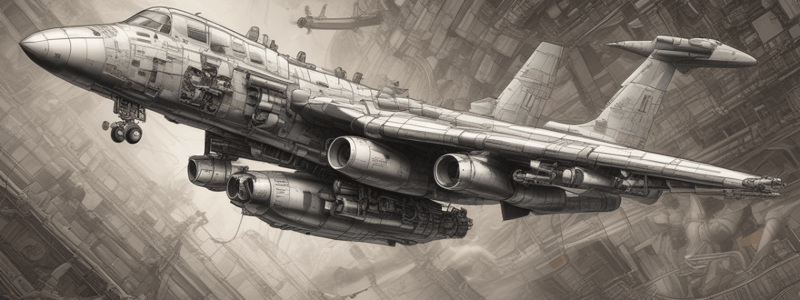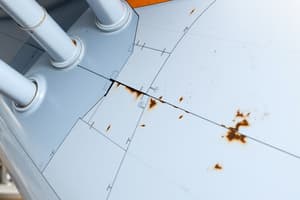Podcast
Questions and Answers
What happens if a countersinker is set too deep?
What happens if a countersinker is set too deep?
- The hole is enlarged and the metal will shear across the head (correct)
- The hole will be smaller and the metal will be stronger
- The rivet will be driven faster
- The countersinker will break
Why should you avoid countersinking too far when working with thin material?
Why should you avoid countersinking too far when working with thin material?
- The rivet will not be driven properly
- The countersinker will break
- The riveted joint will be weakened (correct)
- The hole will be enlarged and the metal will shear across the head
What is the purpose of supporting the preformed head with a dolly when hand riveting?
What is the purpose of supporting the preformed head with a dolly when hand riveting?
- To hold the rivet in place
- To make the rivet head smaller
- To drive the rivet faster
- To ensure the sheets are drawn together (correct)
What is the correct sequence to form a reaction head when hand riveting?
What is the correct sequence to form a reaction head when hand riveting?
How should the rivet be driven when hand riveting?
How should the rivet be driven when hand riveting?
What is the purpose of a draw tool in hand riveting?
What is the purpose of a draw tool in hand riveting?
What is used to drive aircraft solid rivets in pneumatic rivet guns?
What is used to drive aircraft solid rivets in pneumatic rivet guns?
What is the action applied to the rivet snap in pneumatic rivet guns?
What is the action applied to the rivet snap in pneumatic rivet guns?
What is the main reason why lap joints are not used in high-performance aircraft?
What is the main reason why lap joints are not used in high-performance aircraft?
What is the purpose of using a doubler in a flush joint?
What is the purpose of using a doubler in a flush joint?
What type of joint is a combination of flush and lap joints?
What type of joint is a combination of flush and lap joints?
What is the advantage of using flush joints in aircraft manufacturing?
What is the advantage of using flush joints in aircraft manufacturing?
What is the purpose of a lap patch?
What is the purpose of a lap patch?
What is the characteristic of a lap joint?
What is the characteristic of a lap joint?
What is another use for joggle joints?
What is another use for joggle joints?
What is the substructure used in flush joints?
What is the substructure used in flush joints?
What is the primary purpose of deburring holes after drilling?
What is the primary purpose of deburring holes after drilling?
What tool can be used as an alternative to a deburring tool if it is not available?
What tool can be used as an alternative to a deburring tool if it is not available?
What is the primary purpose of a snap in solid riveting?
What is the primary purpose of a snap in solid riveting?
What is the purpose of a dolly in solid riveting?
What is the purpose of a dolly in solid riveting?
Why is it important to ensure no gaps are present between layers during riveting?
Why is it important to ensure no gaps are present between layers during riveting?
What is the purpose of applying sealant during riveting?
What is the purpose of applying sealant during riveting?
What tool is used to draw the metal sheets together during solid riveting?
What tool is used to draw the metal sheets together during solid riveting?
What is the primary method of riveting used on aircraft structures?
What is the primary method of riveting used on aircraft structures?
What is the advantage of using a C-yoke or alligator-yoke squeezer?
What is the advantage of using a C-yoke or alligator-yoke squeezer?
What is the purpose of the bucking bar?
What is the purpose of the bucking bar?
Why is it important to use the fewest blows possible when forming a rivet?
Why is it important to use the fewest blows possible when forming a rivet?
What is the driving face of the bucking bar machined for?
What is the driving face of the bucking bar machined for?
How is the correct pressure of the rivet gun adjusted?
How is the correct pressure of the rivet gun adjusted?
What is the purpose of holding the bucking bar flat and square against the rivet's tail?
What is the purpose of holding the bucking bar flat and square against the rivet's tail?
What should be done with the rivet gun trigger?
What should be done with the rivet gun trigger?
What is the purpose of the wood during rivet gun adjustment?
What is the purpose of the wood during rivet gun adjustment?
What could be the cause of a cracked shop head?
What could be the cause of a cracked shop head?
What is the purpose of countersinking the skin in NACA riveting?
What is the purpose of countersinking the skin in NACA riveting?
What tool is used to mill the excess material from the shank in NACA riveting?
What tool is used to mill the excess material from the shank in NACA riveting?
What is the cause of a burr under the rivet head?
What is the cause of a burr under the rivet head?
What is used to confirm a gap under the rivet head after installation?
What is used to confirm a gap under the rivet head after installation?
Why is the NACA riveting technique used?
Why is the NACA riveting technique used?
What happens to the rivet after it is installed in NACA riveting?
What happens to the rivet after it is installed in NACA riveting?
What is the result of a rivet set that is too big for the rivet?
What is the result of a rivet set that is too big for the rivet?
Flashcards are hidden until you start studying
Study Notes
Riveted Joints
- Three types of riveted joints are used in aircraft manufacturing and repair: lap joints, flush joints, and joggle joints.
Lap Joints
- In a lap joint, the skins are riveted together, resulting in a distinct step or change in levels.
- The skins are not on the same plane, but are stacked.
- Lap joints are not suitable for aerodynamic smoothness due to disrupted airflow during flight.
- They are generally used on light aircraft where aerodynamic smoothness is not a concern.
- Lap patches are an example of where lap joints are used.
Flush Joints
- Flush joints are used to obtain aerodynamic cleanliness between two skins.
- The skins are riveted to the same substructure, putting them on the same plane.
- The substructure can be longerons, bulkheads, formers, etc.
- A separate metal piece called a doubler may also be used as the substructure.
- Flush patches are an example of a flush joint.
Joggle Joints
- A joggle joint is a combination of flush and lap joints.
- One skin is joggled to accommodate the other, producing one smooth side.
- Joggle joints are also used when fitting doublers over other internal structure.
Deburring
- Holes should be deburred after drilling using special deburring tools.
- If a deburring tool cannot be sourced, use a larger diameter drill bit to achieve similar results.
Solid Riveting Tools
- Solid rivets can be closed by hand using appropriate snaps, sets, and dollies.
- A set (also known as a draw tool) is a hollow punch used to draw the metal sheets together and bring the preformed rivet head against the metal surface.
- A snap is a form of punch with a recess at one end, the same shape as the rivet preformed head.
- A dolly is a metal block with a recess the same shape as the preformed head of the rivet, used to support the preformed rivet head.
Hand Riveting
- Hand riveting may be convenient for small jobs or those done away from the aircraft.
- When solid rivets are closed with a hand hammer, the preformed head should be supported in a dolly.
- A hollow set or draw tool is used to ensure the sheets are drawn together.
- The tail is then driven using a flat snap to form a reaction head with a thickness of 0.5D.
Pneumatic Rivet Guns
- Aircraft solid rivets are often driven with pneumatic rivet hammers or guns.
- Pneumatic rivet guns use compressed air to drive a piston back and forth, applying a hammering action to the rivet snap.
- This method offers several advantages, including producing uniformly sized shop heads, reducing installation time, and being suitable for use with two types of guns: C-yoke and alligator yoke.
Bucking Bars (Dollies)
- The shop head is formed by the bucking or vibrating action of a bucking bar when the rivet gun is activated.
- Bucking bars come in many different sizes and shapes for different applications.
- The driving face of the bar is machined smooth and polished so that no marks are left on the rivet tail.
Using the Rivet Gun
- Prior to installing rivets, the gun needs to be adjusted for correct pressure/hammer.
- This is achieved by actioning the gun against a piece of wood and adjusting the airflow to indent the wood but not shatter it.
- Place a rivet in the hole and hold the gun against its head with enough pressure to keep the rivet against the skin.
- Hold the bucking bar flat and square against the rivet’s tail and pull the trigger to form the rivet.
Common Riveting Errors
- Burr under head: not deburred correctly.
- Cut shop head: dolly did not cover entire end of rivet.
- Cracked shop head: hard rivet or hit too long.
- Skin marked by oversize rivet set: set head is too big for rivet.
- Skin marked by rivet set: set not centered on head of rivet.
NACA Riveting
- NACA (National Advisory Committee for Aeronautics) flush riveting technique is used to install a rivet with a flush shop head.
- The skin is countersunk and the rivet installed from inside the structure.
- The rivet is driven to fill the countersink.
- A micro-shaver is then used to mill the excess material from the shank and obtain a flush surface.
Studying That Suits You
Use AI to generate personalized quizzes and flashcards to suit your learning preferences.





